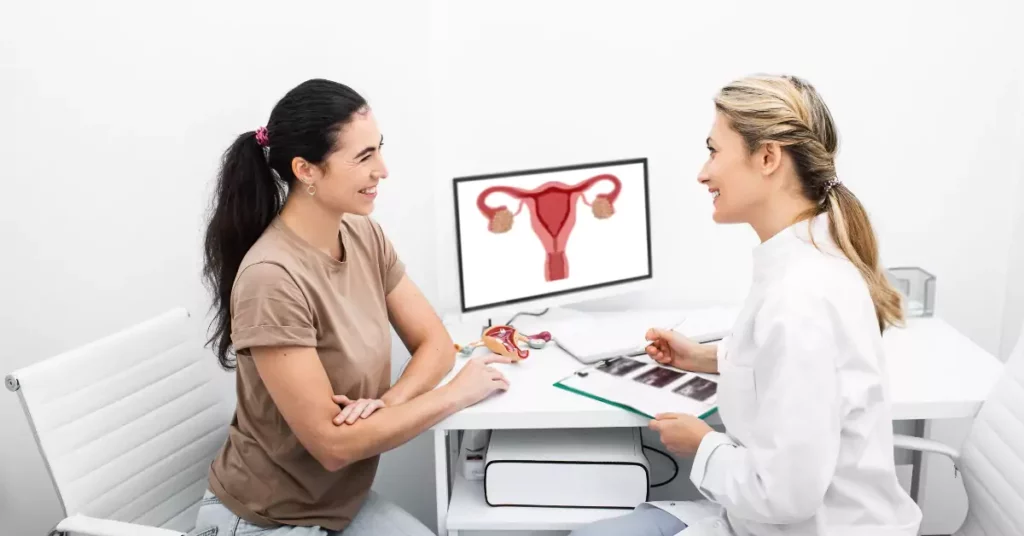Fibroids Symptoms: Signs and When to Seek Help
Fibroids, medically known as Uterine Leiomyomas, are non-cancerous growths that develop in or around the uterus.
While fibroids typically develop within the muscular wall of the uterus, they can occasionally arise in other locations within the pelvic cavity.
They are often benign and can cause various symptoms that impact a person’s quality of life.
Fibroids can manifest differently depending on their location within the reproductive system.
Understanding the fibroids symptoms associated with uterine and cervical fibroids is crucial for timely diagnosis and management.
Where can fibroids grow
Understanding the location of fibroid growth is essential to understand its impact on the body.
Fibroids mainly grow in the uterus wall and are categorized into three groups:
- Submucosal fibroids grow into the uterine cavity
- Intramural fibroids grow within the uterine wall
- Subserosal fibroids grow on the outside of the uterus
However, in some cases, fibroids can also grow outside the uterus.
These fibroids that grow outside the uterus are referred to as Extrauterine or Extrauterine fibroids.
Extrauterine fibroids can develop in various locations within the pelvic cavity.
Common sites where extrauterine fibroids can grow include:
- Pedunculated fibroids: These fibroids grow on stalks or peduncles ( a structure connecting the fibroid to the surface of the uterus or within the uterine cavity), resembling mushrooms, and can extend beyond the uterus into the pelvic cavity or abdominal cavity
- Broad ligament fibroids: Fibroids can arise within the broad ligament, which is a fold of the peritoneum that attaches the uterus, fallopian tubes, and ovaries to the pelvic sidewall
- Cervical fibroids: Fibroids can grow in the cervix, the lower part of the uterus that connects to the vagina
Symptoms of Fibroids

Fibroids can develop in different areas of the reproductive system, leading to a diverse range of symptoms.
Women with fibroids may encounter:
- Heavy or extended menstrual bleeding
- Bleeding episodes between periods
- Abdominal discomfort or feeling full
- Pelvic pain
- Lower back discomfort
- Bladder issues like frequent urination or trouble emptying the bladder
- Bowel problems like constipation or straining during bowel movements
Additionally, fibroids can lead to:
- Challenges with fertility
- Pregnancy complications
- Pain during sexual intercourse

Are you looking for a good and reliable medication to relieve Fibroid pain?
Get the best pain medications from WowRx.
Brufen 400mgNaprosyn 500 +Apart from these common symptoms, specific types or conditions related to fibroids may exhibit additional or distinct symptoms:
- Submucosal fibroids: Can cause heavy menstrual bleeding, which can lead to Anemia; due to their location within the uterine cavity
- Large fibroids: May cause significant abdominal distension, pressure symptoms, or difficulty with movement
- Subserosal fibroids: May present with back pain, urinary frequency, or digestive disturbances due to their location outside the uterus
- Pedunculated fibroids: May cause acute pain if the fibroid twists on its stalk, leading to torsion
- Calcified fibroids: Often asymptomatic but may cause pain or pressure if they outgrow their blood supply or undergo degeneration
- Stomach fibroids: Rare but can cause bloating and make them appear larger if they grow large enough to affect adjacent organs
Read “7 Foods For Shrinking Fibroids Effectively” to learn about natural remedies for managing fibroids.
Discover how incorporating certain foods into your diet can help reduce fibroid size and alleviate symptoms.
When to seek a doctor

It’s important to visit your doctor if you experience:
- Persistent pelvic pain
- Heavy or painful periods that interfere with your activities
- Spotting or bleeding between periods
- Difficulty emptying your bladder
- Continuous fatigue and weakness, which could indicate anemia, a condition characterized by low red blood cell levels
Also read: For a detailed understanding of the diagnostic procedure and identifying Fibroids, dive into our article “How to Diagnose Fibroids? Essential Tests to Identify Uterine Fibroids.”
Conclusion
Understanding fibroid symptoms, whether uterine or cervical, is vital for prompt diagnosis and management.
Symptoms like heavy menstrual bleeding, pelvic pain, and urinary issues can significantly affect daily life.
Seek medical help if you experience persistent pelvic pain, heavy periods, bleeding between periods, difficulty emptying your bladder, or ongoing fatigue and weakness.
Early intervention can improve your quality of life and prevent complications.
Frequently Asked Questions
What are the main symptoms of fibroids?
Fibroid symptoms can include heavy menstrual bleeding, pelvic pain and pressure, frequent urination, abdominal swelling, back pain, pain during intercourse, and reproductive challenges such as infertility or pregnancy complications.
How can I manage fibroid symptoms?
Management of fibroid symptoms may involve medication to alleviate discomfort, hormonal therapies to regulate menstrual cycles or surgical interventions such as myomectomy or hysterectomy. Discuss your options with a healthcare provider to determine the most appropriate treatment plan for your individual needs.
Can fibroid symptoms impact fertility?
Yes, fibroids can affect fertility by interfering with implantation or causing complications during pregnancy. However, many individuals with fibroids are able to conceive and carry pregnancies to term with appropriate medical management and support.
Are there lifestyle changes that can help alleviate fibroid symptoms?
While lifestyle changes alone may not eliminate fibroids, adopting a healthy lifestyle can support overall well-being and may help alleviate symptoms. This includes maintaining a balanced diet, staying physically active, managing stress, and avoiding tobacco and excessive alcohol consumption.
WowRx uses only high-quality sources while writing our articles. Please read our content information policy to know more about how we keep our content reliable and trustworthy.






